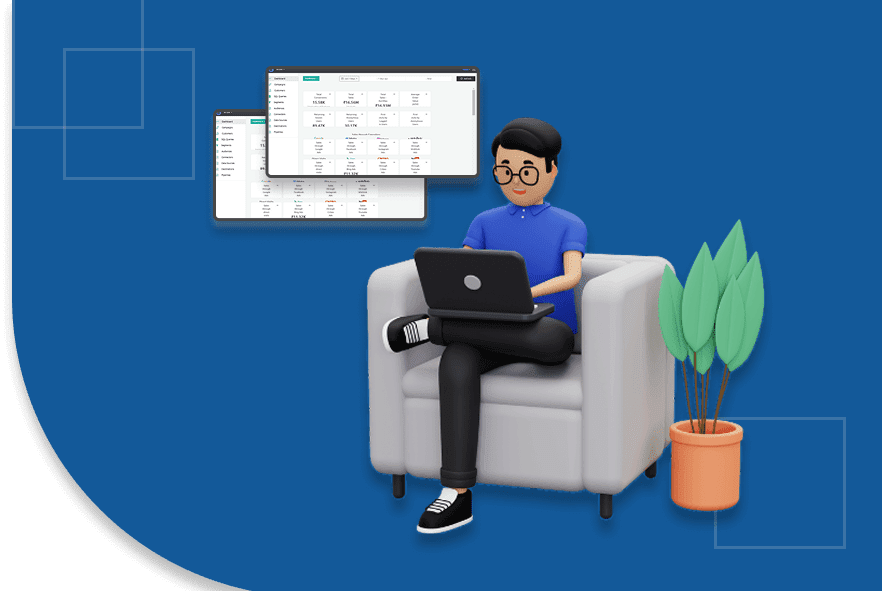Ever wish your ads could pop up right when your next customer gets a caffeine craving or a sudden urge to shop? With geotargeting, you’re practically in their pocket—even if you’re actually across town!"
Your ads appear right where people shop, eat, or even near competitors' stores. With geotargeting, this isn't just a dream—it's real. As people run their errands at a café or a large shopping center, your offers catch their attention with deals they can’t resist.
This smart method puts your brand in the center of their everyday life, fitting into their local habits and grabbing potential customers just where you want them. It's like putting a billboard on their path, but much more focused and effective.
In this blog, we'll show you how geotargeting can help you get your message across, make your ads sharper, and turn every local spot into a chance to win customers. Get ready to take your marketing to the next level with geotargeting.
First, let's understand about geotargeting.
What is Geotargeting?
Geotargeting is a marketing technique where ads are shown to people based on their physical location. This strategy ensures that the advertisements people see are relevant to the places they are at that moment, like showing a coffee shop ad to someone nearby, making it more likely they'll visit.
Geotargeting uses location data to show ads in the right place at the right time. By knowing where people are, you can display ads that catch their attention and match their surroundings. This goes beyond just showing ads based on location—it connects people to things they might need or want at that moment.
Accurate data collection is essential to ensure your ads are relevant to users' locations. Learn how Ingest Labs' Advanced Tag Management tools can streamline your data collection process.
With geotargeting, you can create ads that speak to local preferences and needs. This leads to more engagement and higher conversions. Geotargeting doesn’t just place ads—it makes them smarter and more connected to people’s lives.
Now, let’s look at how geotargeting uses location data to create these personalized ads.
How Geotargeting Works
As stated earlier, geotargeting determines a user’s location using various technologies to ensure the data is precise and actionable. For a deeper understanding of how to enhance your marketing with reliable data, explore our insights on server-side tracking.
The most common technologies used to determine location include:
- GPS(Global Positioning System): GPS uses satellites to track a device's precise location. This method is highly accurate and is commonly used on mobile devices, making it ideal for apps and services that rely on real-time location data, such as navigation or delivery apps.
- Cell Towers: In areas where GPS signals may be weak, such as inside buildings or in urban environments with tall structures, cell tower signals can be used to triangulate a user's location.
- IP Addresses: Geotargeting can estimate a user’s location by analyzing their internet connection's IP address. It’s often used in desktop-based campaigns or when more precise data isn’t available.
Once the system finds the user’s location, it shows ads based on the local demographics and behavior. This means the ads fit the user’s environment and needs at that moment.
For example, a coffee shop may promote its morning deals to people nearby during peak commuting hours, or a retail store could advertise a weekend sale to users in a specific neighborhood.
This ensures that ads are not only location-appropriate but also relevant to the user’s current context, increasing the likelihood of engagement and conversions.
Let’s dive into the different types of geotargeting you can use to make your ads even more effective.
Types of Geotargeting
To optimize the effectiveness of marketing campaigns, geotargeting can be applied in various forms, each suited to different strategic needs:
Region or City-Level Geotargeting
This form of geotargeting focuses on broader areas, such as regions, states, or entire cities. It’s particularly useful for large-scale campaigns aimed at building brand awareness or promoting products and services to a wide audience.
For example, a national brand may target a whole city with a campaign to increase visibility, ensuring that consumers across the area are exposed to the ads. This type of geotargeting works well for companies that want to reach large, diverse groups of people while still maintaining some level of localization.
ZIP Code Geotargeting
This method allows you to narrow your audience to specific ZIP codes, making it ideal for reaching more minor, more defined local communities. Businesses like restaurants, retail stores, or service providers can use ZIP code targeting to focus on consumers who live or work near their locations.
It’s an excellent way to promote neighborhood events, seasonal sales, or localized services, helping businesses connect with their most immediate audience. This precision boosts relevance, as it allows marketers to focus on areas that are more likely to engage with their brand.
Radius or Proximity Geotargeting
This strategy targets users within a set distance from a specific location, such as a store, event venue, or point of interest. By setting a radius—say, 5 miles around a store—businesses can attract nearby consumers who are more likely to visit.
This method is highly effective for time-sensitive promotions or local businesses looking to grab the attention of physically close people. For example, a coffee shop might offer a limited-time offer to nearby users during morning hours, encouraging quick visits.
You can apply different types of geotargeting to maximize your campaign's effectiveness Find out how tracking across multiple channels can further improve your geotargeting efforts.
Let's take a closer look at geotargeting and geofencing!
Geotargeting vs. Geofencing
While geotargeting and geofencing both rely on user location, they work differently. Geotargeting focuses on placing ads based on a user’s location, using additional data like behavior and demographics to show relevant content. It helps you customize ads to specific regions, cities, or even neighborhoods, ensuring the message fits the local audience.
Geofencing, on the other hand, creates a virtual boundary around a physical area. When a user enters or exits this zone, it triggers an action, like sending a notification or displaying an ad. Businesses often use geofencing around specific places like stores, events, or even competitor locations to engage customers at the exact moment they are nearby, encouraging immediate action.
While you're here, explore addressable advertising, another advanced strategy for delivering personalized ads to specific audiences.
After seeing how these methods work, it's time to see what's in it for you
Benefits of Geotargeting
Geotargeting brings a range of benefits that can help businesses improve the effectiveness of their marketing strategies:
Enhanced Relevance:
Geotargeting allows businesses to show highly targeted and personalized ads based on a user’s location, behavior, and preferences. This method ensures that your ads are relevant to the user’s current environment, making them more likely to engage.
For instance, showing ads for umbrellas on a rainy day or promoting nearby restaurants around lunchtime provides immediate value to the consumer, boosting the chances of conversion.
Boosts Local SEO
Geotargeting plays a significant role in improving local search engine optimization (SEO). By delivering ads and content that are geographically relevant, your businesses become more visible to people searching for services or products in their area.
This means when someone searches for "coffee shop near me," geotargeting helps your business rank higher in local results, driving more foot traffic and increasing online visibility within the community. Geotargeting isn't the only way to boost your SEO. Learn more about how to use website tags and meta tags to improve your search rankings and drive local traffic.
Improved Customer Engagement
Geotargeting enhances customer engagement by showing users ads specific to their location and immediate needs. Consumers are more likely to respond to timely and relevant content, whether it’s driving them to an online sale or encouraging them to visit a physical store.
This approach bridges the gap between digital and in-person experiences, making it easier for businesses to connect with their online and offline audience, ultimately improving overall engagement and sales.
Improving engagement starts with knowing your customers. On that note, find out how first-party data can help you create personalized campaigns and drive better results.
Okay, so how can businesses really use Geotargeting? Let's get into it.
Applications of Geotargeting
Geotargeting has numerous applications that businesses can leverage to refine their marketing efforts and connect with their audience in more meaningful ways:
Localized Advertising
Geotargeting enables businesses to create ads that resonate with local cultures, languages, and community preferences. For example, a brand might use regional slang or references in its ads to connect with a specific city's residents, making the message stand out in a crowded marketplace.
Location-Based Promotions
One of the most powerful uses of geotargeting is offering special discounts or promotions based on the user’s geographic area. For instance, a restaurant could send a lunch discount to nearby office workers, or a retail store might promote a weekend sale to local shoppers, driving higher foot traffic and sales.
Geo-Conquesting
Geo-conquesting is a strategic move in which businesses target customers who are near their competitors' locations. For example, if a potential customer is near a rival coffee shop, your brand could pop up with an ad offering a discount at your nearby café, tempting them to choose your business instead.
These geotargeting applications provide businesses with the tools necessary to create more impactful, location-specific campaigns, enhancing the relevance and engagement of every ad and offer for their target audience.
We've talked about strategy, but what about precision? Let's find out.
Accuracy and Effectiveness of Geotargeting
Geotargeting is transforming digital marketing with its ability to deliver highly precise ads. Here are key points that highlight the accuracy and effectiveness of geotargeting:
- Precision in Targeting: Geotargeting's precise nature makes it a preferred strategy for marketers who aim to connect directly with their target audience, offering a stark contrast to the broad-spectrum approach of traditional advertising.
- Focused Advertising: It allows ads to be specifically directed at users in defined locations, drastically reducing wastage of ad spend and improving campaign results. Learn more about the tools that enhance this precision on our digital property tracking page.
- Cultural Resonance: Marketers can harness detailed location data to target individual ZIP codes, cities, or entire regions, crafting campaigns that resonate with the local culture, needs, and preferences—thus driving higher engagement and increased conversion rates.
- Enhancing Impact: By focusing on exact locations, geotargeting ensures that ads are not only relevant but also highly impactful, as they reach the audience most likely to engage. This strategic focus boosts both customer engagement and overall marketing effectiveness.
- Data Accuracy: Effective geotargeting relies on precise and accurate data collection. To improve your geotargeting accuracy, explore Ingest Labs' advanced tracking solutions.
Geotargeting enhances marketing precision and impacts success by ensuring ads reach the right people at the right time.
Conclusion
Geotargeting has become a vital tool in modern marketing, allowing businesses to reach customers where they are, with ads that resonate with their location and needs. By focusing on specific areas such as ZIP codes, cities, or regions, geotargeting delivers more personalized and relevant ads, helping businesses increase customer engagement, drive foot traffic, and improve overall conversion rates.
Geotargeting enables businesses to effectively reach customers and customize advertising strategies for specific regions. This precision is vital for companies looking to enhance their advertising impact and engage audiences meaningfully.
To refine your approach and measure campaign success, explore how multi-touch attribution offers insights into the customer journey, improving data-driven decisions and optimizing marketing efforts.
Geotargeting turns every local opportunity into a potential customer win, making it indispensable in today’s marketing toolkit. With tools from Ingest Labs, you're not just participating in geotargeting; you're mastering it. With Ingest Labs, you can stay ahead of the competition and make the most of geotargeting to boost your marketing success.
Ready to elevate your marketing game with pinpoint precision? Connect with Ingest Labs and discover how our solutions can transform your strategies today!






